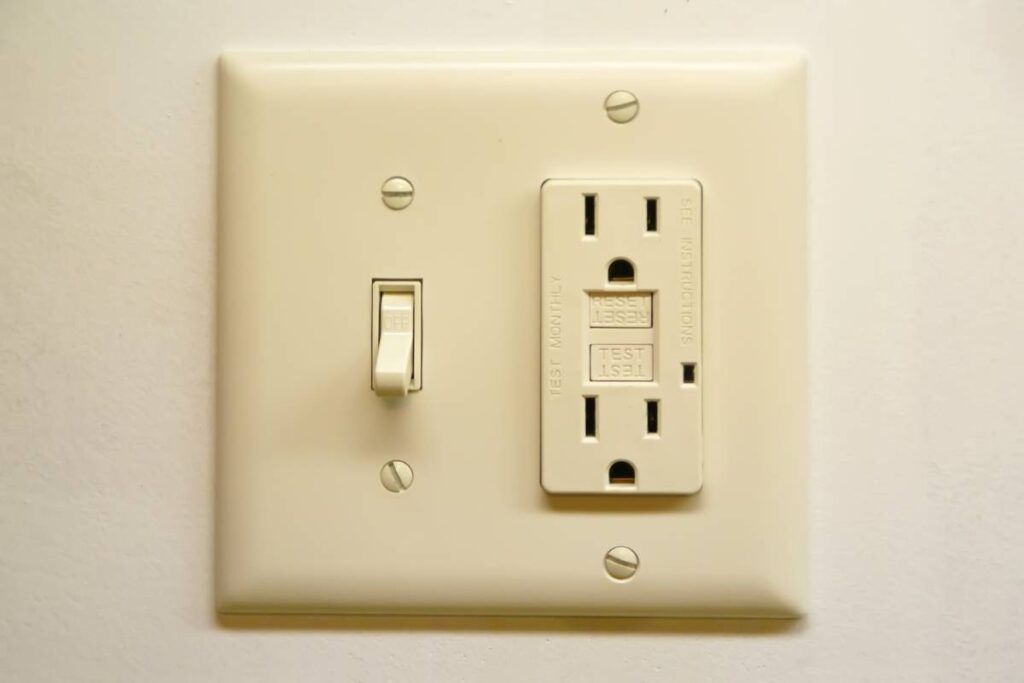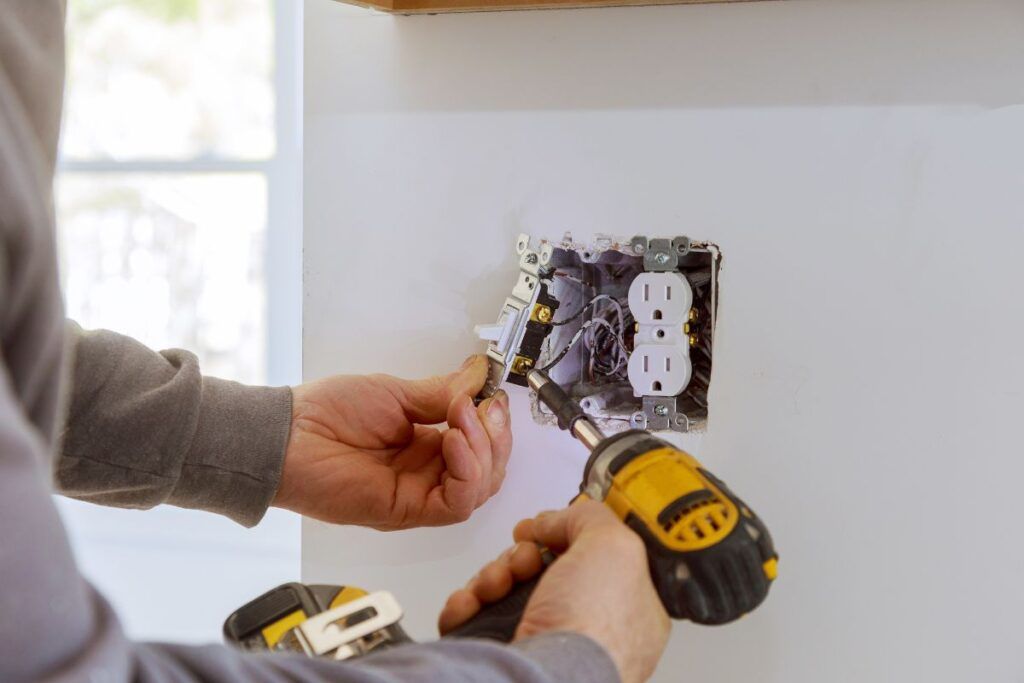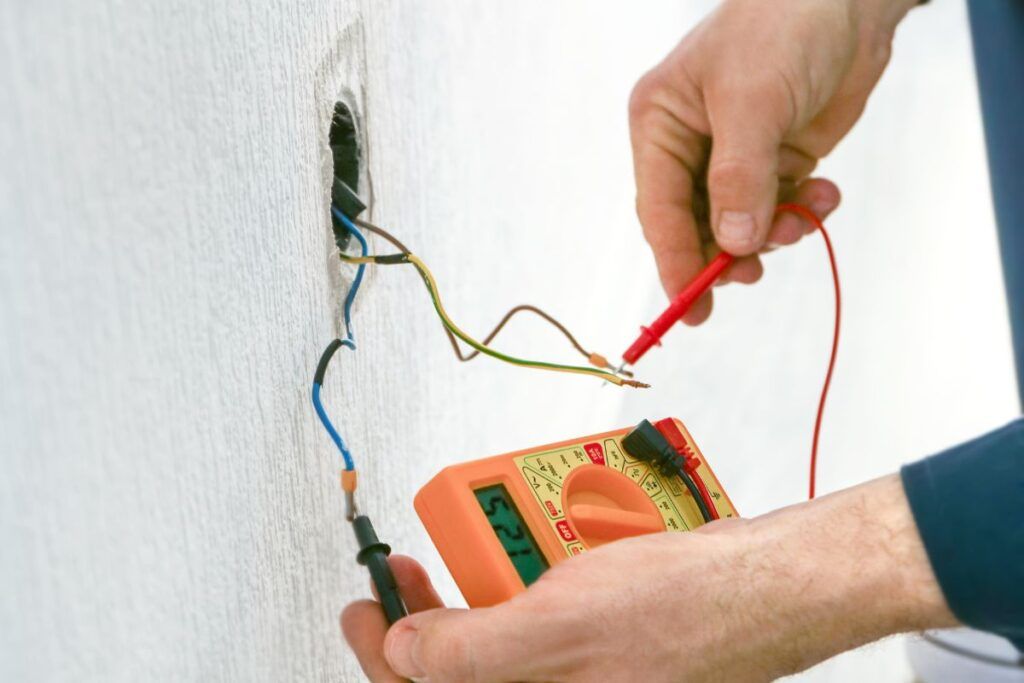The switched outlets are the wall switches that control the power of a receptacle. It means you can turn the outlet power on or off anytime. But is it possible to always turn a switched outlet hot? Let’s figure it out.
To turn a switched outlet hot all the time, remove the outlet plate, cover the red wire with a cap, connect the white wires to the other white wires and the black to the connector’s hot side. Make sure to check the wire connection, tuck in the wires, and reinstall the plate.
Only a few minor wire connections can help you always convert the switched outlet hot. If you are a newbie, this guide will help you know the steps to make a switched outlet hot, the reasons to do it, and common issues you may face during the wiring.

Check out our list of top-handpicked products for all your electrical, appliance, and HVAC system needs to keep your home running smoothly.
This post includes some affiliate links.Understanding switched outlets
A switched outlet is an outlet that you can control with the help of a wall switch to turn it ON and OFF whenever needed.
In a switched outlet, one slot will always have power. A wall switch will control the other slot.
A switched outlet is, therefore, also called a duplex or half-hot outlet.
You can also turn the entire outlet ON and OFF from a wall switch.
Still, only one of the two plug-ins in the outlet will be powered permanently for other usages.
A switched outlet is common in offices and modern buildings, especially living rooms, to control the lamps and fans.
You can install these outlets in the new buildings or add them to your existing outlets.
Before you install a switched outlet in your home, consult a licensed electrician for local code permission.
When you modify the existing outlet, you don’t have to replace the old outlet.
The square, decora-switch, or semi-round type can be used as a switched outlet.
However, if you have a GFCI, you must replace the entire outlet to turn it into a hot one.
If you have purchased a new outlet, it should match the circuit breaker’s ampacity.
Reasons for making a switched outlet hot all the time
When you turn a switched outlet hot, you no longer need to control the outlet with a switch.
Hot outlets can have many benefits, especially for those devices that constantly run, such as refrigerators.
I have one switched outlet for my refrigerator.
There are many reasons for making a switched outlet hot all the time, and below are the major reasons:
Convenience
Some devices in the houses will need to be powered constantly, for example, a clock, a refrigerator, or a charger.
So, turning it on and off too much can be annoying and inconvenient.
If you turn a switched outlet to hot and connect these appliances to the outlet, you do not have to turn them on and off too often.
You can keep these appliances powered without worrying about turning on the switch.
Safety
Sometimes, keeping a switched outlet off can be a safety hazard.
Since one outlet slot remains hot, you might connect a few appliances to the outlet that must be run constantly.
For example, a sump pump or a refrigerator.
In such a condition, if you suddenly turn the outlet off, the device connected to the outlet to receive power will damage and lead to serious issues.
Turning the outlet hot all the time will prevent these safety hazards and keep your devices safe.
Compatibility
Some appliances are not meant to connect to the switched outlets.
In such a condition, it would be better to turn the outlet hot to ensure these appliances run properly.
Safety precautions when working with electrical outlets

Working with electrical outlets can be dangerous.
That is why most house owners leave it to the hands of a licensed electrician.
But if you have experience, here are a few precautionary tips for you:
- I always turn off the power at the breaker before working with any outlet, and sometimes the main breaker for extra precaution. You should also turn off the circuit breaker powering the outlet, if not the main breaker.
- After turning off the breaker, use a voltage tester to ensure no power is running in the outlet. I use a multimeter.
- Avoid working around wet areas, and do not touch any electrical parts with wet hands.
- Use the right tools while working with the electrical outlets.
- Avoid using frayed cords, damaged insulation, and broken plugs.
- Avoid overloading the circuit with too many appliances.
- Wear protective gear like goggles and insulated gloves.
- Do not touch any energized outlets. Check the outlet’s voltage with a multimeter, turn it off, and then work with it.
- If you are in doubt, hire a professional to fix the outlet.
Basic principles of electrical wiring
While working with electrical outlets and wiring, you should follow a few principles:
- While choosing wires for the outlet, keep the length to a minimum level to avoid resistance and voltage drops.
- Ensure to connect the wires in the outlet tightly. Double-check if needed.
- Select the right wire size and type that matches the current-carrying capacity of the outlet’s circuit breakers.
- The electrical wiring should be well-insulated to prevent the electrical current from flowing through unindented paths.
- Connect the electrical wirings with the correct polarity.
- The electrical wiring must ensure the continuity of the entire circuit.
- After you finish the wiring, ground the wire properly to avoid short circuits and electrical accidents.
- Before you wire an outlet, you must plan the wire route and the connections.
Tools and equipment required for turning a switched outlet hot all the time

Turning a switched outlet hot will need a few wire connections.
Below are some materials that you will need to turn the switched outlet hot:
- Screwdriver
- Wire nuts
- Pliers
- Voltage tester
- Electrical tape
- Wire cutter or stripper
- A new outlet, especially if you have a GFCI split receptacle
Steps to make a switched outlet hot all the time
Converting a switched outlet to hot is simple, provided you follow the steps properly.
Let’s jump into the steps I followed to turn a switched outlet hot all the time:
Step 1: Turn off the power
Start with turning the power off at the circuit breaker.
Turning the power off at the circuit breaker will stop the electrical flow in the cables and prevent electrocution while working.
Use a voltmeter to ensure the wires have no power left.
Sometimes, the power keeps running despite turning off the circuit. So, use a voltmeter or a voltage tester to confirm it.
Step 2: Remove the cover plate
Remove the outlet’s cover plate to look at the wire connections.
You will find two screws holding the outlet in its place.
Unscrew the screws to pull out the outlet from its place.
You will see two wires – white and black wires.
Unscrew the top half of the outlet from the bottom half and remove the faceplate by unscrewing the screws holding it in place.
Step 3: Cover the red wire with a cap
There will be two wire types to power the electrical outlet – white and black wires.
The black is the hot wire, and the white is the neutral wire.
Additionally, there might be another red wire, which serves as the switch wire.
The switch helps to turn the outlet on and off.
Seal the red wire after ensuring no power is left in the wires.
Seal the wire and push it behind the box.
After you disconnect the switch, tape the wire ends separately.
Step 4: Arrange the wires correctly
The white wires in the outlet box must be attached to the other white wires.
Remove the white wire from the box’s connector outlet with a screwdriver.
The black wires will be attached to the hot side of the connectors.
You can also use a pigtail.
If you have a GFCI split receptacle, you may need to replace the receptacle.
Use a wire nut or pigtail to connect all the black wires.
Use a separate nut to attach the white wires similar to the black wires.
Electrical materials are difficult to attach to the old sockets. So, use a modern electric plug.
Screw the wires in the right receptacle clockwise with a screwdriver. It will keep the wires from slipping out of the outlet.
Step 5: Disconnect wires from the switch
The switched outlet is converted to a hot outlet.
Now you need to replace the switchboard’s wall switch.
Snip the linked wires after removing the switch powering the outlet.
Use a small wire nut to cap the hot and neutral wires of the switch.
Then tuck the wires inside at the rear.
Put the switchboard away using a switch cover.
You can get the exact size of the real switch and easily install them.
Instead of the switch cover, you can leave the switch in place and use it as a dummy switch.
How to replace a switched outlet with a standard outlet?

A switched outlet means a half-hot outlet. You are turning it into a full hot outlet.
If you want a normal outlet, replace the switched outlet with a new one or reconfigure the wires properly.
Here are the steps for the replacement:
- Turn off the power at the circuit breaker.
- Remove the cover plate and check it with a non-contact voltage tester to ensure all the power is dead.
- Remove the outlet from the box and pull it out. Take a picture or remember the wire connections. You will need it to rewire the new outlet.
- Disconnect all the wires from the old outlet with the help of wire cutters or strippers.
- Put the new outlet and connect the wires to it. The black wire will be on the gold or brass terminal, the white wire on the silver terminal, and the ground or bare wire on the green screw terminal.
- Tuck the wires back into the box and attach the new outlet box.
- Replace the cover plate and turn back the power.
To reconfigure the wire connections, here are the steps:
- Turn the power off, remove the faceplate, and check the wires with a voltage tester to ensure no power runs.
- Unscrew the outlet box and take it out.
- Identify the wires first. The switched outlet will have a black or red wire connected to the brass screw and a white wire on the silver screw on the same side. Another black or red wire will be capped off and unattached to the outlet.
- Disconnect the wires of the switched outlet, remove the capped wire, and connect it to the other black or red wire with a wire nut. It will make a constant circuit and give power to both outlets.
- Connect the white wire to the silver screw on the new standard outlet and the black wire to the new outlet’s brass screw.
- If your new outlet has a ground screw, connect the green wire.
- Push the wire back into the box, screw the outlet, and put back the faceplate.
- Turn the power back and check with a voltage tester to ensure the power is running.
Since outlet wiring is complicated, you can always hire a professional for installation and wiring.
Electrical works are dangerous, and mistakes can cause accidents and expensive damages.
Common issues when making a switched outlet hot all the times
When you turn a switched outlet hot, you disconnect the switch and link it to a constant power source.
The process is beneficial in many ways, but you will face a few issues:
- While working with electricity, there is always a chance of electrocution. Turning a switched outlet hot increases the risk of electrocution and other hazards.
- When an outlet is constantly hot, it already has a heavy load. If the switched outlet gets overloaded, it can trip the breaker more frequently than the normal outlets and breakers.
- A hot outlet will consume more energy than the other outlets because it always remains energized.
- Wiring problems can create serious electrical issues in the hot outlet. The risks of accidents are more in the hot outlets because it no longer remains under any switch’s control.
- Some appliances do not perform well with hot outlets. As a result, there arises a compatibility crisis.
- Any electrical work you do must obey the local codes. When you turn a switched outlet hot, you must ensure that it is allowed in the building code of your region.
Troubleshooting tips for electrical outlet issues

Any kind of electrical outlet is prone to creating issues if circumstances are created.
If your outlet is not working as expected, here are a few things you should check for troubleshooting the problems:
- If your outlet is not working, check the other outlets to see if they are working. Plug in other appliances to this outlet and other outlets to confirm whether the appliance or the outlet is the issue.
- If no outlets are working, you might have a tripped breaker. Check the breaker and reset it if it has tripped.
- Check the outlet for wire connections. Loose connections or frayed wires can cause issues like outlets not working or becoming hot.
- For loose connections, tighten the wires. If the wires are frayed or damaged, replace them with new ones.
- The outlets have metal contact points inside the device that grips the hot, neutral, and grounding prongs. Check that these contacts are in good condition. If they have worn out, you should replace the outlet.
- See if the outlet has cracks in its body. Replace them immediately.
- The outlet matching should match the circuit. You can use a smaller outlet for a larger circuit, but the opposite can create issues. If you have a larger outlet for a smaller circuit, it can result in tripped breakers. Check the rating and replace the outlet.
- The GFCI outlet will trip if it senses an issue. Check the outlet and see if it has tripped. If the problem persists after resetting, a ground fault might need an electrician’s attention.
- If you still cannot troubleshoot the problem, call an electrician.
Hiring a professional electrician for assistance
Working with electrical outlets will always have dangers. So, hiring a professional to deal with it is always best.
A professional will detect and solve problems correctly with the right process.
If you want to turn a switched outlet hot, professionals can do it correctly and faster with the right tools and equipment.
The professionals have proper training in these things.
So they can identify the wires and where to connect which wire for turning a switched outlet.
You can also do it. But without enough experience, you might make mistakes in the first few steps and incur expensive damages. You do not expect this from a professional.
As a result, the work is genuine, to the point, and faster.
Since the professionals are trained, they have vast knowledge about the building codes.
So, they will work by following all the codes and regulations, saving you from penalties.
While hiring an electrician, try to provide as much information as possible.
It will help him find out the right issue and solve it properly.
It may cost a few dollars if you call an electrician. But you can save money in the long run and avoid expensive damages.
If this is your first time attempting electrical work, hire a licensed electrician.
Final thoughts
Making a switched outlet hot is simple if you follow the right process. You only need to perform a few wire connections. The half slot of the switched outlet will always remain hot while the other half is controlled with a switch. You can turn off the entire outlet with a switch.
Turning a switched outlet hot allows you to use appliances that must be run constantly, such as refrigerators and sump pumps. That is why people prefer turning the switched outlet to hot.
However, there are some issues to consider. A switched outlet increases the risk of electrocution, always remains energized and overloaded, and consumes more energy. Before you make such a setting, check with the local codes for permission. Since outlets are complicated, hiring an electrician is better than doing it alone.
How can I bypass the outlet light switch?
Remove the switch and unscrew the switch. Connect the black wire from the outlet with the switch’s black wire and screw the switch back into the electrical box and replace the plate.
Can I break a tab on a switched outlet?
Turn the power off and remove the screws holding the switch plate. Once you see the tabs holding the switch in place, use needle-nose pliers to break the tab gently.
Reference: Electrical Outlets Wikipedia
